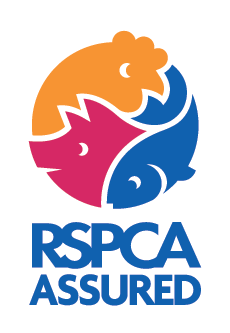The life of an RSPCA Assured salmon
From egg to supermarket shelf, the life of an RSPCA Assured salmon is about three years long. The RSPCA Assured logo can only go on products which have been raised from birth to slaughter (referred to as harvest in salmon farming) to the RSPCA’s strict higher welfare standards. But what goes on behind the scenes? We spoke to an RSPCA Assured salmon farmer about the process to see what happens on a farm and what difference being RSPCA Assured makes.

It all starts with the eggs
The aquaculture-sourced salmon eggs are brought into the hatchery, and this is where they stay for the first year. Everything in the hatchery has been designed to replicate the fish’s natural habitat as closely as possible: the trays where the fish hatch simulate the gravel where the fish would be born in the wild, and the flow of water in the tanks replicates the strong river currents. Even their food is designed to float on the top of the water, recreating the fish’s natural feeding technique of coming to the surface to consume dead bugs.
Moving to salt water after the first year
Just as salmon in the wild are born in fresh water and migrate to the sea, farm-raised salmon are also moved into salt water at about one year. At this stage, the fish normally measure about six inches in length and undergo a series of changes referred to as smoltification. This is when they first develop their characteristic silver colouring.
Recreating the salmon’s natural environment
Imitating their natural behaviour, the salmon ‘school’ together, that is, they bunch up close to one another. In the wild, fish do this to protect themselves against predators and feel more secure. While the fish prefer to swim like this, they actually have a lot of space to swim around, even more so on RSPCA Assured salmon farms.
The amount of fish that can be kept together in one pen is referred to as the stocking density. On non-RSPCA-assured farms, the maximum stocking density is between 20 and 25 kilos of salmon per cubic meter of water. However, on an RSPCA Assured farm, this is limited to 15 kilos per cubic metre.
Protecting the fish in their pens
Salmon farmers take a lot of precautions to protect their fish, including using different types of nets to keep out predators. The mesh of salmon pens is now made from a strong material which is not only apt at keeping out predators such as seals but also birds that might come swooping down from above. These preventative measures help the fish to live more tranquil and stress-free lives.
In addition to protection from predators, it is also an essential responsibility of the salmon farmer to ensure the environment where the fish are living is safe. This involves regular checks to ensure the water is not just clean and at the right temperature but also that the oxygen and salinity (the level of dissolved salt in the water, typical seawater is around 35 parts per thousand or grams per litre) levels are constant and anomalies are detected as early as possible.
A sample of the water is also checked daily under a microscope for microorganisms and even jellyfish. That’s right; microscopic jellyfish can get into the pens and sting the fish, and if this happens on their gills, it can cause breathing problems.
Other threats to fish wellbeing
Ensuring that strict biosecurity measures are in place on the farm to protect the fish from disease is vitally important. Whilst all fish farms have their specialist equipment, such as pens, nets, feeding systems and workboats, which are kept clean and safe for use, it is sometimes necessary to bring in external equipment. On these occasions, they need to be thoroughly cleaned to avoid bringing in external pathogens.

How do they track the weight of the fish?
Underwater cameras allow modern-day salmon farmers to see what’s going on below the surface. By monitoring the feeding habits, salmon farmers are able not only to ensure the fish are given the correct amount of feed but also to accurately gauge their weight based on daily consumption. Using underwater cameras also allows farmers to monitor the behaviour and well-being of the salmon and identify any changes which could signify a problem. This is even more important when you cannot see the salmon from the pen side.
When are the salmon slaughtered?
Once transferred to a saltwater habitat, the salmon remain in the pens for 14 to 22 months before being slaughtered. This usually takes place when the salmon reach five kilos, although this can change depending on the demands of the market.
Harvesting the salmon
When it is time to slaughter the fish, they are first graded for size using a device such as a passive grader. This is a net which collects fish over a certain size while permitting smaller fish (not yet of slaughter weight) to slip through gently. The fish are then transferred onto a live-haul vessel by a pump. The RSPCA has strict standards that must be met during this process, such as time limits on crowding, to ensure that any stress to the fish is minimised.
Once on board the vessel, the fish are kept in a tank of oxygenated water and are constantly monitored throughout their journey to the harvest station. On arrival, the fish are humanely slaughtered in line with strict RSPCA welfare standards.
The circle begins again
Once the sea farm has been emptied, it will remain fallow (empty) for several weeks or months before the next generation of salmon is delivered and the process starts again.
